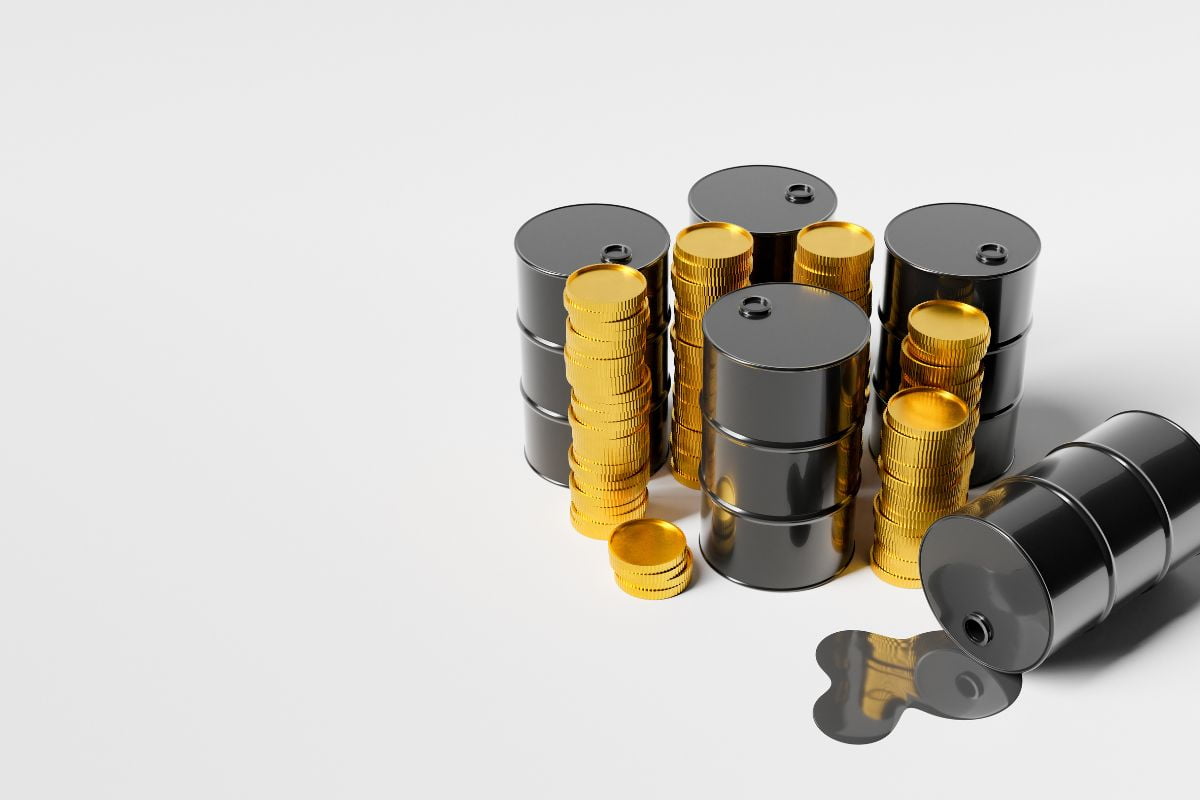Gold CFD is a financial instrument which allows traders to trade gold with a margin as low as $1. In this article, we will go through the details of what gold CFD is and how to trade it.
What are CFDs on Gold
CFDs on gold are derivatives of Contracts for Differences based on gold, enabling traders to speculate on gold prices without getting involved in the spot or futures market.
Let’s compare gold CFD with two other popular gold investing channels:
- Physical gold investment: extra costs for physical delivery and storage, profits can only be made when the gold price rises.
- Gold futures trading: allows for both long & short but has complex margin rules, and requires a minimum margin of $500.
In gold CFD trading, there is no physical delivery, and the margin calculation is simple. It supports a minimum trading size of 0.1 ounces, with the lowest required margin being less than $1.
Gold Futures & Spot CFD
Depending on the underlying market, there are two types of CFDs on gold: gold futures CFD and gold spot CFD.
1). Gold Futures CFD
The underlying market for gold futures CFD is the gold futures traded on the CME. Similar to futures, there are different contract months for gold futures CFD trading at the same time. Unless otherwise specified, when discussing gold futures CFD, it refers to the CFD based on the lead month futures contract.
Furthermore, gold futures CFD is associated with the same expiry date as the underlying futures. The open position will be closed upon expiry, and traders who wish to continue trading will need to open a new position in the next contract month.
The contract month and expiry date can sometimes pose challenges, or even result in additional losses for casual individual traders. For example, some traders may select the wrong contract month and forget about the expiry date.
2). Gold Spot CFD
Gold spot CFD, derived from the spot gold market, reflects the gold price for immediate delivery. As XAUUSD is the code for spot gold, it is also commonly used as the trading symbol for gold spot CFD.
Unlike futures CFDs, gold spot CFDs can be traded continuously, without any expiry date. Consequently, they are more popular among individual traders. Therefore, we will focus more on spot gold CFD in the remaining content of this article.
Spot Gold CFD Contract Size
The contract size of the smallest micro gold futures is 10 ounces. As mentioned earlier, the margin requirement for gold CFD is much lower than for futures, does this also mean a smaller contract size for CFD? In fact, there is no standardized contract size for spot gold CFD. Some brokers may use a contract size of 100 ounces, while others may adopt 10 ounces.
However, since the contract size of 100 ounces is commonly used in gold trading contracts, most CFD brokers also use this size. What really makes a difference is not the contract size, but rather the minimum trading lot size. While the minimum trading size for futures is 1 lot, even for the micro contract, it is only 0.01 lots for CFDs on gold.
- For a contract size of 100 ounces, 0.01 lots is equivalent to 1 ounce.
- For a contract size of 10 ounces, 0.01 lots equals only 0.1 ounce.
A smaller minimum trade size naturally results in a lower trading threshold. Additionally, CFDs on gold are traded with margin, meaning traders only need to deposit a small amount of margin to open a position. The next section will detail the calculation method for gold CFD margin.
Margin of CFDs on Gold
In contrast to the complex margin rules of gold futures, gold CFD trading involves a straightforward margin requirement that remains consistent throughout the trading process. Below is the calculation formula for the margin of gold CFD, based on the contract size of 100 ounces:
Gold CFD Margin = ( Open price × Trading lot × 100) ÷ Leverage
The leverage offered by CFD brokers can vary significantly, ranging from 1:100 to 1:1000 for CFDs on gold. The table below outlines the margin required for 1 lot, 0.1 lots, and 0.01 lots of gold CFDs, assuming a leverage ratio of 1:400, when gold is trading at $2100:
| 1 lot (100 ounces) | 0.1 lots (10 ounces) | 0.01 lots (1 ounce) | |
| Gold CFD Margin | $525 | $52.5 | $5.25 |
The lowest margin ris only $5.25, compared to nearly $500 for micro gold futures. Even when considering the same trading value, 1 lot (10 ounces) of micro gold futures requires a margin of $484, while 10 ounces of gold CFD only costs $52.5 in margin.
For CFD brokers that adopt a contract size of 10 ounces and support a minimum trading size of 0.1 ounce, it only requires a tiny margin of less than $1 to start trading.
Costs of Gold CFD Trading
1). Trading Spread Cost
The spread, which represents the difference between the ask and bid prices, constitutes the primary trading cost in gold CFD trading. The spread shown in below is 0.2, indicating that traders will incur $0.2 in spread charges for every ounce traded at the given price.
Most CFD brokers use variable spreads, which means the spread fluctuates around a typical value under normal market conditions. However, it’s crucial to note that the spread for gold CFDs can increase significantly during thin or volatile markets, and the spread may vary among brokers.
Below is the comparison for the trading costs between micro gold futures and gold CFDs:
- Micro gold futures: $1 for a round turn trade of 1 lot (10 ounces)
- CFDs on gold: $2 for trading 10 ounces on spread charges.
From the perspective of trading cost, CFDs on gold and micro gold futures are on the same level.
2). Rollover Charges
Rollover charges, also referred to as swap fees, are applicable to gold spot CFD positions held over 5 PM EST. The direction of the trade, whether long or short, determines whether traders incur charges or receive positive swap fees. Presently, long positions in CFDs on gold will be subject to rollover fees, while short positions will accrue rollover fees.
The rollover charges can vary significantly between different brokers. Additionally, traders may incur swap fees irrespective of their trading direction.
Gold CFD Trading Hours
In line with the underlying market, both spot gold CFD and gold futures CFD are traded 23 hours a day, five days a week. The gold market opens at 06:00 on Monday (GMT+8) during US daylight saving time and closes at 05:00 on Saturday. Each trading day includes a one-hour break between 05:00 and 06:00.
- US daylight saving time:Monday 06:00 – Saturday 05:00, with one hour daily break 05:00 – 06:00.
- US winter time:Monday 07:00 – Saturday 06:00, with one hour daily break 06:00 – 07:00.
The extended trading hours of gold CFDs provide casual individual traders with great convenience, allowing them to trade during their off hours.
Gold CFD trading Brokers
1). ThinkMarkets
| Trading symbol | XAUUSD | Max leverage | 1:500 |
| Contract size | 100 ounces | Regular spread | 0.2 |
| Platform | MT4/MT5/ThinkTrader | Min trading lot | 0.01 lots |
| Regulation | UK FCA, AU ASIC, Japan FSA, NZ FMA, Cyprus SEC, South Africa FSCA | ||
2). INFINOX
| Trading symbol | XAUUSD | Max leverage | 1:1000 |
| Contract size | 100 ounces | Regular spread | 0.25 |
| Platform | MT4/MT5 | Min trading lot | 0.01 lots |
| Regulation | UK FCA, South Africa FSCA, Bahamas SCB, Belize FSC | ||
3). Exness
| Trading symbol | XAUUSD | Max leverage | 1:1000 |
| Contract size | 100 ounces | Regular spread | 0.2 |
| Platform | MT4/MT5 | Min trading lot | 0.01 lots |
| Regulation | UK FCA, Cyprus SEC, South Africa FSCA | ||
4). Oanda
| Trading symbol | XAUUSD | Max leverage | 1:888 |
| Contract size | 100 ounces | Regular spread | 0.2 |
| Platform | MT4/MT5/FXTRADE | Min trading lot | 0.01 lots |
| Regulation | US NFA, UK FCA, AU ASIC, Japan FSA, Singapore MAS | ||
5). Pepperstone
| Trading symbol | XAUUSD | Max leverage | 1:500 |
| Contract size | 100 ounces | Regular spread | 0.18 |
| Platform | MT4/MT5 | Min trading lot | 0.01 lots |
| Regulation | UK FCA, AU ASIC, Cyprus SEC, Dubai FSA | ||






